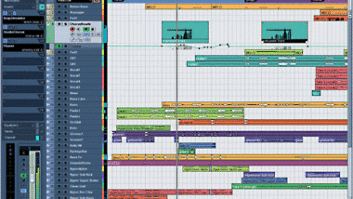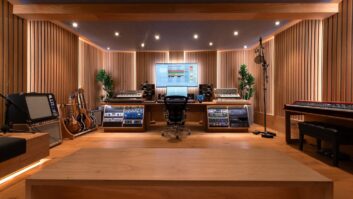The favorite purchase of the last 12 months for composer, producer and remixer Ian Nieman of Nieman Music in Canada is his API 1608 mixing console.Despite the prevalence of software in the music production process, engineers working with personal recording setups still rely heavily on hardware. In an unscientific survey of a handful of engineers working across the audio spectrum, from composition through music recording, mixing and remixing, hardware— even furniture—tops the list of must-haves and favorites from the last 12 months.

Of course, software is a given in almost any production system these days. “For me, everything starts with Pro Tools|HD,” insists Ian Nieman, a Juno Award- winning composer, producer and remixer whose Toronto, Canada-based Nieman Music facility specializes in original music for recording artists and for placement in film and television. “It has been my go-to DAW for 10 years. I love it for editing, recording, mixing, etc. It’s a must-have.”
Canadian-born Ryan Shore, a Grammy-nominated composer for film, television, games and records, agrees: Software is at the center of everything in his personal studio, which is located in Burbank, CA. Most recently, he reports, “I picked up the latest versions of Pro Tools and Logic. Those are my two main programs that I use for recording and sequencing. They’re so integral to the process, it would be hard to imagine working without them.”
For Ryan Hewitt, a Grammy Award-winning recording and mixing engineer who can be found at his Lock Stock Studio in Venice, CA when he’s not working at a commercial facility somewhere in the world, software upgrades have to be scheduled around a busy workload. Still on Pro Tools 8, Hewitt plans to move to version 10. “But I’m in the middle of four records, and I’m loath to change things midstream. As soon as these are out of the way and on the shelf, then I’ll change to 10. I’m looking into the whole HDX upgrade to see where the functionality of that system is. The bump in power is massive, and I need that for the way that I mix.”
Los Angeles-based KamranV is a music industry innovator who set up Spaceland Records after spearheading new media and mobile initiatives with several major labels. His recent acquisition of the RME Fireface UFX 60-channel interface has improved the recording and webcasting workflow of his mobile setup immensely, and is a new favorite piece, he reports.
“It opens up a whole new world for super-compact, inexpensive, multitrack recording and webcasting,” he enthuses. “We can simultaneously record and mix the webcast through the UFX to Pro Tools and have a direct-todisc multitrack recording right from the UFX’s USB port. If the computer or Pro Tools dies, we’re safe without having to lug around a second recorder.”
Nieman, too, is enthusiastic about his most recently acquired hardware piece, a Burl Audio Mothership converter system. “Man, that thing is stunning!” he declares.
Film composer Ryan Shore has acquired plenty of software this past year, but his custom writing desk, incorporating his Yamaha Motif 8 controller, is his favorite purchase.But of all the equipment that he purchased over the last 12 months, he adds, “That would have to be, without a doubt, my API 1608 [mixing console].” Nieman purchased the console through Mike Nehra at Vintage King Audio.

Nieman, who has created original hits and remixes for Mariah Carey, LeAnn Rimes, Nelly Furtado and Jason Derulo, and won Canada’s Juno Award for an original song created for the TV series, Queer Eye for the Straight Guy, has plenty of experience with API gear. Over previous years, he used an array of API outboard gear, and for many years paired his Pro Tools HD rig with an API 7800/8200 combination.
Depending upon the application, Nieman has a short list of go-to gear in his studio. ”For tracking vocals, I always use a Sony C800g or Neumann U67 going to a vintage Neve 1067, followed by a Tube-Tech CL1B into a Neve 33609. This has been my go-to setup for years,” he shares. “For tracking synths, I use a [Signal Transport’s] Synth Driver II. That is an awesome unit and certainly makes using older analog synths a dream. For mixing, I love using a Shadow Hills Mastering Compressor on the 2-bus.”
As a scoring composer who often writes for orchestra, Shore depends on software instruments. Recent sample library acquisitions include LA Scoring Strings, from Audiobro, and ProjectSAM’s Symphobia, which he runs in Native Instruments’ Kontakt. But in his studio, his must-have audio hardware includes a 5.1 setup of Genelec monitors, including 1031As across the front.
“They’re a staple part of my setup. I love the way that they sound. I find them to be very flattering, and since I do presentations here at my studio for filmmakers, I always try to present all of the music in the best way that I can.” Shore continues, “The other piece of gear that I love is my main controller, the Yamaha Motif 8. It’s a very modified Motif 8; I had it opened up, gutted and built directly into a custom-made piece of furniture, my writing desk.”
Since film composers need access to a keyboard and a computer, finding the right setup can be difficult. “I feel like I have spent a lifetime trying to get the ergonomics to feel right in my studio,” admits Shore. “This is the only one that has felt completely right, and it was completely custom-built by a wood craftsman.”
Shore’s scores can also include atmospheric and sound-design elements, and he typically turns to software there, too. “One really go-to piece of software that I’ve been using for years is [Spectrasonics’] Omnisphere. When I start looking for those types of sounds, I always look there first. They all sound good, they have nice endings and beginnings, and motion to them. I’m so grateful for it; the sounds are so playable and just ready. In the type of work that I do, the schedules are usually very tight, so anything that’s not ready to go may not be usable.”
The one must-have in Hewitt’s studio? “Great musicians!” he laughs. Joking (or semi-joking, anyway) aside, “For mixing, I’ve got to have [a UREI] 1176 [compressor]; that’s probably my favorite piece of gear. And if I can’t have that, then I’ve got to have the UAD 1176. That’s probably far and away my most used and most prized possession.”
As for recent acquisitions, says Hewitt, “Chandler Little Devil preamps; I just got those a couple of weeks ago. They’re phenomenal.”
Favorites from the last year? “I got a pair of Germanium preamps, from [designer] Wade [Goeke]. I love those.”
Like, Shore, Hewitt has also benefited from a new piece of furniture. “I just got a new Sterling Modular desk. I’ve known [owner] Jim Maher since I was 12 years old; he built a studio that my dad [David Hewitt, of Remote Recording Services fame] used to work in a lot. It’s really fun to come back and be able to work with someone like that. It has made my workflow so much more comfortable.”
KamranV, who is also a musician, has a favorite instrument that is applicable in the studio or on the road. “I love this little AKAI LPK25 [Laptop Performance Keyboard] mini USB keyboard controller. You can bring it anywhere, and having it around lends itself well to the whole process. You can go from just working out parts all the way to actually laying it down without dealing with much setup in whatever sized space you have,” he says.
Direct Sound’s Extreme Isolation EX-29 headphones are another new favorite, according to KamranV. “They’re perfect for the live situations that we’re in to block out the noise. We ended up getting this ‘jam hub’ version that’s a multi-pack version and actually color-codes the headphones. They’re so good for the studio; it keeps things much less confusing.”







